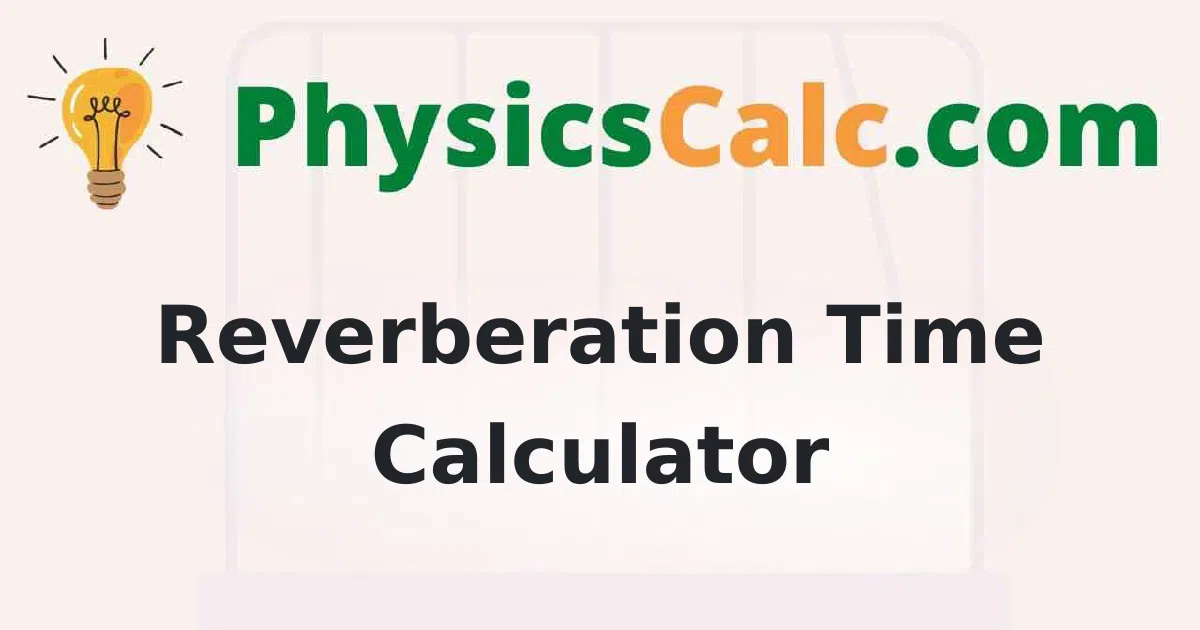Reverberation Time Calculator
This free Reverberation Time Calculator is helpful to determine the reverberation time of a room in frcation of seconds along with the detailed explanation. Enter room length, room height, room width, doors, windows, height, width and number of windows, doors in that room in the input fields and click on the calculate to obtain the reverberation time along with the effective absorbing area as output easily.
Step by Step Process to Calculate Reverberation Time
Have a look at the step by step process on how to find the reverberation time of a room or auditorium. We have two methods to find the reverberation time. One is using a device and other is using the room dimension. RT60 equation is best for getting the reverberation time using the room parameters. Get the steps and follow them carefully.
- Get the room dimensions and doors, windows dimensions.
- Fimd the volume of the room by multiplying its length, width and height.
- Find the product of area of the part of room's surface and its absorption coefficient.
- Sum up all those product to get the effective absorbing area.
- Divide the volume by effective absorbing area.
- Multiply the result by to get the RT.
Reverberation Time Formula
In general, sound is a wave propagating in the air. A sound wave travels forward until it reaches an obstacle. After wave hitting the obstacle, its enery gets absorbed by the barrier or wave gets reflected in opposite direction from the obstacle. After some time, many times sound get reflected and most of the energy gets abosorbed. At this time, the sound pressure level decreases.
The time between the sound emission and moment when SPL drop is 60 dB is called the reverberation time. It is purely depends on the sound frequency.
Reverberation time can be calculated with the help of RT60 equation. Here RT means reverberation time and 60 is the 60 decibles. RT60 equation is also known as the sabine formula. This RT60 equation builds the relation between absorptive properties and reverberation time. And this formula is given below.
RT60 = 0.163 * V/A
Effective absorbing area formula is A = α₁S₁ + α₂S₂ + ... + αₐSₐ
Where,
V is the total volume of the room
A is the is the effective absorbing area of the room
RT60 is the reverberation time
S is the area of the specific part of the room surface
╬▒ is the absorption coefficient of that surface
Optimal Reverberation Time Formulas
The following are the different purposes to estimate the optimal reverberation time.
- Communication T = 0.32 * log V - 0.17
- Music performance T = 0.45 * log V + 0.17
- Speech T = 0.37 * log V - 0.14
- Music reharsel T = 0.47 * log V - 0.37
Example
Question: Find the reverberation time of a hall having dimensions 40 x 30 x 20 and having the absorption coefficient of 0.15.
Solution:
Given that
Length of hall l = 40
Width of hall w = 30
Height of hall h = 20
Average absorption coefficient ╬▒ = 0.15
Volume of the hall = lbh
= 40 * 30 * 20 = 24000
Surface area of the hall S = 2[(40 x 30) + (30 x 20) + (20 x 40)] = 2[1200 + 600 + 800]
= 5200
Total average absorption is A = 0.15 x 5200 = 780
Sabine formula is RT60 = 0.163 * V/A
= 0.163 * 5200/780
= 0.163 * 6.666
= 1.08 s
The reverberation time of hall is 1.08 sec
Take the help of mathematical tools available on Physicscalc.Com and make the most out of it to understand different concepts easily.
Frequently Asked Questions on Reverberation Time Calculator
1. What is the reverberation time definition?
Reverberation time is the time takes for a sound to decompose by 60 dB and it is abbreviated as T60 or RT60. If reverberation time is less than 0.5 seconds is ideal for good speech clarity.
2. What is an acceptable reverberation time?
Actually, the acceptable reverberation time for a room depends on its intended use. Generally, around 2 seconds is desirable RT60 for medium sized auditorium which is used for both music and speech. T0 for a class room would be less than 1 second and it should be lesser for recording studios. Finally, reverberation time is depends on the absorption coefficient of the surface.
3. What are the different methods to control noise?
The seven methods to noise control are increase distance, reduce the sound power of the source, add absorption/ diffusion, use a barrier, use a masking sound, improve vibration isolation and consider active control.
4. How to reduce reverberation time?
Smooth surfaces cause sound waves to bounce. So it is advised to use soft and absorptive surfaces in a room. Smaller rooms have lesser RT60.
